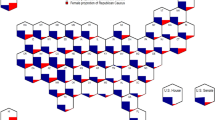Abstract
The gender gap between female and male voters receives much attention during election season. But the partisan gap among women in Congress is a dramatically bigger gulf and arguably holds much more significant consequences for our democracy. This gap has been caused by long-term, structural changes in American electoral politics—specifically, the regional, racial and ideological realignments of the two major political parties.



Similar content being viewed by others
Notes
Unless otherwise noted, statistics on women’s representation referenced in the essay, tables and figures are current as of summer 2019.
Regions are defined following Klinkner and Schaller’s (2006) analysis of regional partisan realignments in Congress.
Further Reading
Abramson, Alana. 2019. “Congresswoman Elise Stefanik has a Plan to get more Republican Congresswomen Elected “Congresswoman Elise Stefanik has a Plan to get more Republican Congresswomen Elected.” Time. May 9. www.time.com
Garcia Bedolla, Lisa, Katherine Tate, and Janelle Wong. 2014. “Indelible Effects: The Impact of Women of Color in the U.S. Congress.” In Women and Elective Office: Past, Present and Future, third edition. Eds. Sue Thomas and Clyde Wilcox. Oxford University Press. 235–252.
Bejarano, Christina E. 2013. The Latina Advantage: Gender, Race, and Political Success. Austen, TX: University of Texas Press.
Brown, Nadia E. and Pearl K. Dowe. 2020. “Late to the Party: Black Women’s Inconsistent Support from Political Parties.” In Good Reasons to Run: Women and Political Candidacy, Ed. Shauna L. Shames, Rachel I. Bernhard, Mirya R. Holman, and Dawn Langan Teele. Philadelphia, PA: Temple University Press. Pp. 153–166.
Center for American Women and Politics (CAWP). 2020. “Women in Elective Office.” Center for American Women in Politics. www.cawp.rutgers.edu.
Congressional Research Service. 2020. Profile of the 116th Congress, Updated June 1, 2020. https://fas.org/sgp/crs/misc/R45583.pdf
Deckman, Melissa. 2016. Tea Party Women: Mama Grizzlies, Grassroots Activists, and the Changing Face of the American Right. New York City: NYU Press.
Elder, Laurel. 2014. “Contrasting Party Dynamics: A Three Decade Analysis of the Representation of Democratic versus Republican Women State Legislators,” The Social Science Journal, 51(3): 377–385.
Klinkner, Philip A. and Thomas F. Schaller. 2006. “A Regional Analysis of the 2006 Midterms.” The Forum 4(3): Article 9. <bepress.com/forum/vol4/iss3/ast9>
Lublin, David. 2018. Eight white majority Districts elected Black Members of Congress this Year: That’s a Breakthrough. The Washington Post. November 19, 2018.
Palmer, Barbara and Dennis Simon. 2006. Breaking the Political Glass Ceiling: Women and Congressional Elections. Routledge.
Smooth, Wendy. 2006. “African American Women and Electoral Politics: Journeying from the Shadow to the Spotlight.” In Gender and Elections: Shaping the Future of American Politics. Eds. Susan J. Carroll and Richard L. Fox. pp. 117–142.
Tate, Katherine. 1997. “African American Female Senatorial Candidates: Twin Assets or Double Liabilities?” In African American Power and Politics, Hanes Walton, Jr., Ed. New York, NY: Columbia University Press.
Author information
Authors and Affiliations
Corresponding author
Additional information
Publisher’s Note
Springer Nature remains neutral with regard to jurisdictional claims in published maps and institutional affiliations.
Rights and permissions
About this article
Cite this article
Elder, L. The Growing Partisan Gap among Women in Congress. Soc 57, 520–526 (2020). https://doi.org/10.1007/s12115-020-00524-0
Published:
Issue Date:
DOI: https://doi.org/10.1007/s12115-020-00524-0




